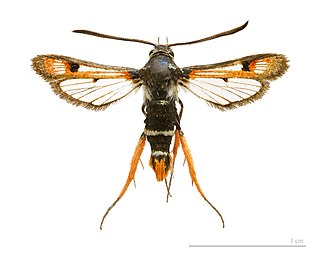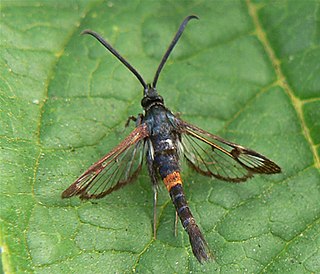
Sesioidea is the superfamily currently containing clearwing moths (Sesiidae), castniid moths (Castniidae) and little bear moths (Brachodidae). There is evidence from head and thoracic morphology that the first two families, internally feeding in plants as caterpillars, are sisters, whilst some brachodids are known to feed on leaf surfaces. Sesioidea are considered to be the sister group of Cossoidea which contain the also internal-feeding Goat and Leopard moths.

Synanthedon culiciformis, known as the large red-belted clearwing, is a moth of the family Sesiidae. It is found in the Palearctic and Nearctic realms.

Synanthedon myopaeformis is a moth of the family Sesiidae and the order Lepidoptera. In Europe it is known as the red-belted clearwing and in North America as the apple clearwing moth. The larvae create galleries under the bark of fruit trees, especially old trees with damaged trunks. During this process, the larvae cause significant damage to host trees. Particular attention has been paid to the damage they cause to apple trees. Their status as a pest of apple orchards has led to many research projects aimed at controlling populations of the moth. This moth is native to Europe, the Near East and North Africa. Recently, the moth was introduced into North America, being first detected in Canada in 2005. There are several organisms that threaten the larvae, including parasitoids, nematodes, and bacteria.

Synanthedon spheciformis, the white-barred clearwing, is a moth of the family Sesiidae. It is found in Europe and Siberia.

Synanthedon tipuliformis, known as the currant clearwing, is a moth of the family Sesiidae. It is endemic to the Palearctic realm, but is an invasive species in the Nearctic realm and the Australasian realm.
Nokona carulifera is a moth of the family Sesiidae. It is only known from Kuranda in Queensland, but probably occurs throughout the western coastal regions of Queensland.
Nokona coracodes is a moth of the family Sesiidae. It is only known from Toowoomba, Queensland.
Pseudosesia isozona is a moth of the family Sesiidae. It is found in Queensland, Australia.
Pseudosesia zoniota is a moth of the family Sesiidae. It is known only from the female holotype which was collected near the Claudie River on the Cape York Peninsula in Queensland, Australia.
Melittia doddi is a moth of the family Sesiidae. It is known only from Queensland, where it was collected near Kuranda.
Melittia chalybescens is a moth of the family Sesiidae. It is known only from Queensland, where it was collected near Kuranda and Mackay.
Ichneumenoptera chrysophanes, the clearwing persimmon borer, is a moth of the family Sesiidae. It is found from Cairns in Queensland to Canberra in the Australian Capital Territory.
Ichneumenoptera commoni is a moth of the family Sesiidae which was described by W. Donald Duckworth and Thomas Drake Eichlin in 1974. It is known only from the male type which was collected near Toowoomba in Queensland, Australia.
Ichneumenoptera xanthogyna is a moth of the family Sesiidae. It is known only from locations near Kuranda in Queensland, Australia.
Synanthedon cupreifascia is a moth of the family Sesiidae. It is known only from locations near Mackay in Queensland.

Bembecia ichneumoniformis, the six-belted clearwing, is a moth of the family Sesiidae.
Oligophlebia is a genus of moths in the family Sesiidae, the clearwing moths. They are native to the Palearctic realm.
Carmenta texana, the Texana clearwing moth, is a moth of the family Sesiidae. It was described by Henry Edwards in 1881 and is known from the US states of Texas and Florida.

Bembecia scopigera, the six-belted clearwing or glearwing, is a moth of the family Sesiidae. It is found from central Spain over most of south-western and central Europe, the Balkans, Greece, southern Russia and Ukraine to Turkey.
Synanthedon flaviventris, the sallow clearwing, is a moth of the family Sesiidae. The larvae form pear-shaped galls on sallows.
This page is based on this
Wikipedia article Text is available under the
CC BY-SA 4.0 license; additional terms may apply.
Images, videos and audio are available under their respective licenses.







